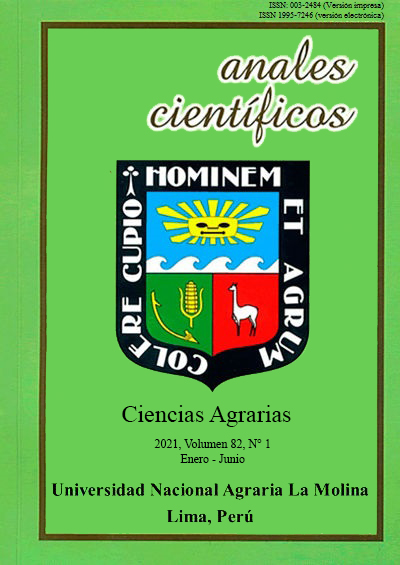Indiscriminated use of pesticides in the rocoto value chain (Capsicum pubescens) in Oxapampa
DOI:
https://doi.org/10.21704/ac.v82i1.1738Keywords:
Rocoto, Value, chains, pesticides, good practices, environmentAbstract
The research presents evidence of the intensive use of chemical pesticides along the links of the value chain of rocoto from the province of Oxapampa (Pasco Region) to the mercado de Lima. The value chain approach was used to analyze the production and supply of rocoto to Metropolitan Lima. The information gathering techniques were formal interviews, observation and review of current regulations on the use of pesticides. Oxapampa is the main supplier of fresh hot pepper to Metropolitan Lima. The results showed that all producers used chemical pesticides at harvest and postharvest, representing 22% of production costs. In the commercialization, the gatherers applied fungicides before sending the fresh rocoto to the Lima market. At the level of wholesalers and retailers, participation was evidenced by influencing decisions on the use of pesticides through the demands of rocoto fruits, of large size, color and without spots. The use of pesticides recommended for other crops was generalized, with prohibited active ingredients and restricted use in other countries (benomyl, paraquat and glyphosate). The practices in the management of pesticides in the links of production and marketing in the value chain of rocoto put at risk both the health of producers and consumers, the environment, and the continuity of this productive activity.
Downloads
References
• APEGA. [Sociedad Peruana de Gastronomía]. (2009). Ajíes peruanos. Sazón para el mundo. Lima, Perú. 122p.
• Astudillo, M., Solís, J., Silva, M., & Maldonado, R. (2019). Cadenas agroalimentarias e innovación social: Perspectivas entre la competitividad y la sostenibilidad, Chilpancingo, México: Universidad Autónoma de Guerrero M; Seropédica, Brasil: Universidad Federal Rural do Rio de Janeiro. 135 pp. Disponible en: http://ri.uagro.mx/handle/uagro/1687
• Briz, J. (2011). La Cadena de Valor como instrumento de análisis del funcionamiento y riesgo del Sistema Agroalimentario. En La Cadena de Valor Agroalimentaria. Análisis internacional de casos reales, 67-95 pp, Coord. Julián Briz, Isabel de Felipe. España. Edit. Agrícola Española. 2011.
• Delgado, J., Alvarez, A., & Yañez, J. (2018). Uso indiscriminado de pesticidas y ausencia de control sanitario para el mercado interno en el Perù. Pan American Journal of Public Health, 1
• FAO- FAOSTAT. (2012). Estadísticas Mundiales de producción con relación a la alimentación y agricultura. Disponible en http://www.fao.org/faostat/es/#data/QCL
• Madeley, J. (2003). Paraquat, el controvertido herbicida de Syngenta. Informe escrito para: Berne Declaration, Swedish Society for Nature Conservation, Pesticide Action Network UK, Pesticide Action Network Asia Pacific, Foro Emaús, RAP-AL. Consultado en: https://silo.tips/download/p-araquat-elcontrovertido-herbicida-de-syngenta-johnmadeley
• MINAGRI. [Ministerio de Agricultura y Riego]. 2013. Semáforo de precios Margen Bruto Minorista de Comercialización en Mercados de Lima Metropolitana. Oficina de Estudios Económicos y Estadísticos. Boletines 2013. Consultados en: https://www.midagri.gob.pe/portal/semaforo-precios/semaforo-2015/category/21-semaforo-de-precios
• MINAGRI. [Ministerio de Agricultura y Riego]. (2013). SISAP (Sistema de Información de Abastecimiento y Precios). Disponible en http://sistemas.minag.gob.pe/sisap/portal/
• INEI. (2012). IV Censo nacional agropecuario. Sistema de consulta de resultados censales. Disponible en http://proyectos.inei.gob.pe/cenagro/tabulados/? id=CensosNacionales
• RALLT. [La Red por una América Latina Libre de Transgénicos]. (2015). ¿Qué sigue después de una prohibición del glifosato – más productos químicos tóxicos y cultivos transgénicos? Publicado por: African Centre For Biodiversity 21 p. Consultado en: http://www.rallt.org/PUBLICACIONES/Informe%20glifosato.pdf
• Sardón, E. (2015). Fortalecimiento de la cadena de valor para el desarrollo sostenible del rocoto (Capsicum pubescens) en la selva central del Perú. Tesis de Magister Scientiae, Universidad Nacional Agraria La Molina, Lima Perú.126 pp
• SENASA. [Servicio Nacional de Sanidad Agraria]. Sf. Normas nacionales sobre plaguicidas. Disponible en: https://www.senasa.gob.pe/senasa/normasnacionales-sobre-plaguicidas/
• SENASA. [Servicio Nacional de Sanidad Agraria]. Sf. Sistema Integrado de Gestión de Insumos Agropecuarios – SIGIA. Disponible en: https://www.senasa.gob.pe/senasa/plaguicidasrestringidos-y-prohibidos-en-el-peru/
• SUNAT-ADUANAS. [Superintendencia Nacional de Aduanas y de Administración Tributaria]. Sf. Operatividad Aduanera. Descarga de Información. Disponible en: http://www.aduanet.gob.pe/aduanas/informae/aepartmen.htm
Downloads
Published
Issue
Section
License
Copyright (c) 2021 Vilma E. Gómez Galarza

This work is licensed under a Creative Commons Attribution 4.0 International License.










